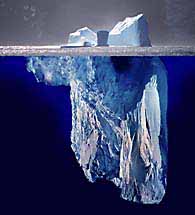Editing Internet Texts/Women in Hemingway's fiction/Hemingway's style
Hemingway started his career as a journalist and while living in Paris in the early 1920s worked for the Toronto Star. Since writing reports required simplicity and objectivity, he developed a minimalistic, paratactical style which was later applied in his fiction. Hemingway prefers to show rather than tell due to which in his works dialogues are easier to find than descriptions. In order to make the narrator invisible, he avoids commenting on the narrative and frequently expresses emotions by means of an objective correlative, describing a character’s emotional state through an object. As a result, his stories are implicit and their underlying significance must be inferred by the reader.
The choice to leave things unsaid is justified in “The Art of the Short Story” where Hemingway writes: “[i]f you leave out important things or events that you know about, the story is strengthened”.[1] This belief serves as a basis for his Iceberg Theory, also called the theory of omission, which is further explained in Death in the Afternoon:
If a writer of prose knows enough about what he is writing about he may omit things that he knows and the reader, if the writer is writing truly enough, will have a feeling of those things as strongly as though the writer had stated them. The dignity of movement of an iceberg is due to only one-eighth of it being above water. A writer who omits things because he does not know them only makes hollow places in his writing.[2]

Hemingway believed that an author should not explicitly state the meaning of a story since if the story is well-written, the deeper meaning becomes evident to the reader. By applying the iceberg theory to his writing, he focused on the surface elements which means that reading his works requires a close examination. Otherwise, the narrative or the characters he portrays may be misinterpreted. It is usually from their dialogues and actions that a character’s personality must be deduced. What is more, he often leaves his stories open-ended which also constitutes a challenge for the reader. Finally, although Hemingway generally opts for objectivity, he also tends to use a first person narrator or provides the reader with insights into the characters’ minds which makes the narration biased and unreliable and, consequently, may contribute to a misanalysis of his fictional characters.
When it comes to the women portrayed by Hemingway, they may be easily labelled as one-dimensional if one looks only at the tip of the iceberg exposed by the author. If, however, what is beneath it is explored, the characters as well as the whole narrative may take on a new meaning. The woman’s side of the story is frequently concealed, but once it is detected, Hemingway emerges as a more feminist writer implicitly exploring the feminine psyche rather than a chauvinist who does not understand or care about women’s needs and feelings.
